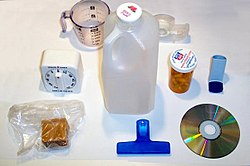
Plastiglomerate is a rock made of a mixture of sedimentary grains, and other natural debris (e.g. shells, wood) that is held together by plastic. [1] It has been considered a potential marker of the Anthropocene, an informal epoch of the Quaternary proposed by some social scientists, environmentalists, and geologists. [2]


